The 2021 Winners of the Lifetime Achievement and Emerging Leader in Chromatography Awards
Paul Haddad and Erik L. Regalado are the winners of the 14th annual LCGC Lifetime Achievement and Emerging Leader in Chromatography Awards, respectively. We review their achievements.
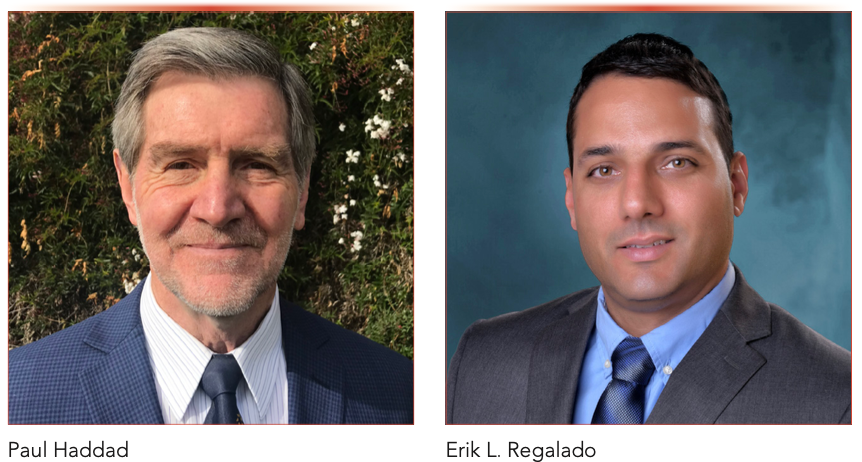
Paul Haddad and Erik L. Regalado are the winners of the 14th annual LCGC Lifetime Achievement and Emerging Leader in Chromatography Awards, respectively. The LCGC Awards honor the work of leading separation scientists for lifetime achievement and emerging potential (Table I). The award winners will be honored at an oral symposium as part of the PittCon 2021 conference, which will be held virtually this year from March 8–12, 2021. The presentations will feature talks by each award winner as well as other leaders in the field of separation science.
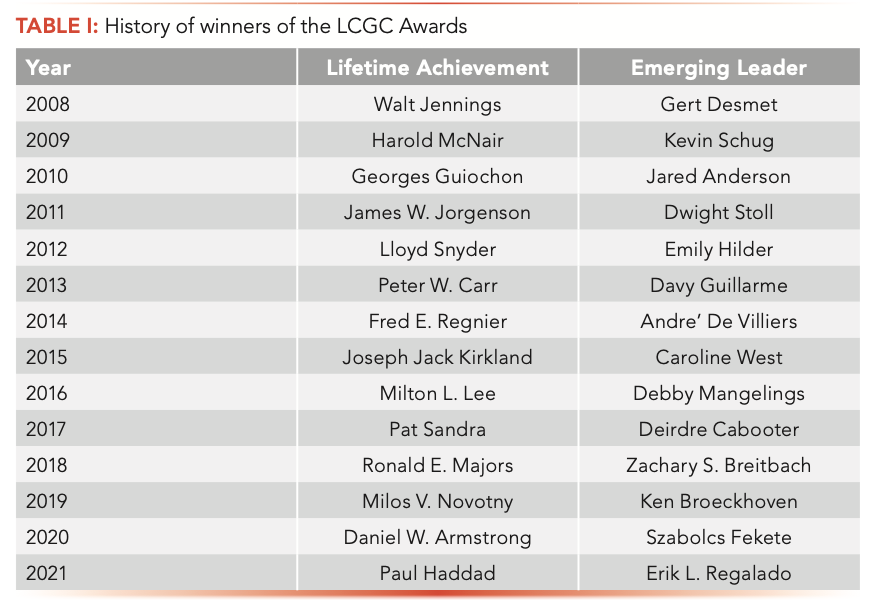
The Lifetime Achievement in Chromatography Award
Paul Haddad, the 2021 winner, is an Emeritus Distinguished professor at the University of Tasmania in Australia and was the foundation Director of the Australian Centre for Research on Separation Science (ACROSS). He is best known for his research on the theory, mechanisms, and applications of analytical separation science in liquid phases, with particular emphasis on the separation and quantification of ionic species.
He received his PhD in analytical chemistry from the University of New South Wales, Australia, in 1975, and his BS degree in 1971 from the same institution. He also holds a diploma of Military Studies (Science) awarded in 1969 by the Royal Military College in Duntroon, Australia. In 1996, he was awarded a Doctor of Science for a career of scientific contributions by the University of New South Wales in Australia.
Haddad has had a broad impact in the field of separation science, across many techniques, including high performance liquid chromatography (HPLC), ion chromatography (IC), capillary electrophoresis (CE), and capillary electro-chromatography (CEC). The focus of his research has been to study separation mechanisms and methods of detection, the goal being to develop mathematical models that improve fundamental understanding of separation mechanisms and apply this understanding to the development of new methods of analysis. Another important area of his research work has been studying detection methods, with an emphasis on potentiometric detection using reactive metallic electrodes and the theory and application of indirect methods of spectrophotometric detection. The separation of complex metal ions and sample handling methods have comprised further major research themes of Haddad and coworkers.
Among Haddad’s greatest contributions is his establishment of ACROSS, where he served as the foundation director from 2001 to 2014, and of the Pfizer Analytical Research Centre (PARC), which he led from 2006 to 2012. ACROSS is recognized worldwide as a leading center of research excellence in separation science. Over the past 16 years, the center has published more than 1000 peer reviewed papers, has graduated 110 PhD students (with 45 currently active PhD students), and presented more than 1500 oral papers or posters at international scientific meetings. PARC was a multimillion dollar research center funded by Pfizer.
Research in Modeling and Optimization of Separation Mechanisms
Haddad’s modeling research has led directly to 115 publications on the fundamentals of separation mechanisms in various chromatographic and electrophoretic systems and the use of mechanistic models for computer-assisted selection of optimal separation conditions. Haddad’s major achievements in this area include the derivation and experimental validation of retention models for cations in the presence of complexing eluents, ion-exclusion chromatography, migration processes in micellar electrokinetic capillary chromatography, and anion separations methods using IC.
The extensive studies carried out by Haddad and his team of computer-based optimization in IC and CE, led to revolutionary new software enabling rapid and accurate simulation and optimization of IC separations in isocratic and gradient elution conditions. This software has been commercialized by Thermo Fisher Scientific as a product called “Virtual Column,” introduced in 2004, and now is reportedly in use in over 2000 laboratories across 30 countries.
Haddad also has explored the use of quantitative structure–retention relationships to predict chromatographic retention in reversed-phase LC (RPLC), hydrophilic interaction chromatography (HILIC) and IC, based only on the chemical structures of analytes. This work sits at the very forefront of research in separation science and the predictions of retention have the best accuracy reported to date.
Studies on the Control of Separation Selectivity in Chromatographic and Electrophoretic Systems
Haddad has conducted systematic studies leading to 182 publications on parameters that influence separation selectivity in chromatographic and electrophoretic systems. One of his major achievements in this area includes the use of functionalized latex nanoparticles for selective ion-exchange separations for microfluidics, CE, and micro-chromatography. He has explored the theory and applications of pseudo-stationary phase CE and CEC systems having variable and predictable selectivity. Haddad has led the study of the fundamentals and applications of electrostatic ion chromatography (EIC) for the determination of inorganic and organic ions in sample matrices of high ionic strength. Haddad first reported separation of all stable metallocyanide complexes, thiocyanate, and free cyanide. He has also designed IC and CE systems for the rapid separation of ions in pre-blast and post-blast samples of improvised explosives leading to the development of instrumentation and methodologies in active use by law enforcement agencies.
Professor Haddad with wife Kerry (left), and some long-term colleagues within ACROSS: Professor Miroslav Macka (and wife Evi), Professor Pavel Nesterenko, and Professor Brett Paull (and wife Estrella). Image and caption courtesy of Brett Paull.

Professor Haddad with long-term industry collaborators and PhD students working together with and within the Training Centre for Portable Analytical Separations Technology (ATech). From left; Mr. Shing Lam, Dr. Steve Hammond, Dr. Sonja Sekulic, Professor Paul Haddad, Professor Brett Paull, Mr. Lewellwyn Coates, and Dr. Andrew Gooley. Image and caption courtesy of Brett Paull.

Exploring Detection and Sample Preconcentration Methods in IC and CE
In another major area of focus, Haddad has produced a large body of work, consisting of 87 publications, on the theory and application of detection methods for a range of chromatographic techniques. His significant contributions in this area include the design and elucidation of electrode response theory for a metallic copper potentiometric detector for IC and CE, the elucidation of the source of “system peaks” in indirect detection in IC and CE, and the comprehensive studies of the theory and fundamentals of online preconcentration using ion-exchange, covering flow-path design, eluent selection, sample loading parameters, and ion-exchange capacity of the concentrator column. Haddad has completed derivation of the fundamental theory of response for indirect detection in CE, and recognition of the key role of the transfer ratio concept. He also has developed an online sample preconcentration methodology for CEC using a latex-coated precapillary and a transient isotachophoretic gradient.
Haddad and coworkers have performed extensive studies on the theory and application of contactless conductivity detection for IC and CE, including microfluidics. Haddad has designed IC suppressors suitable for the detection of organic ions; developed universal response models for aerosol-based detectors in HPLC; and co-invented an on-capillary sample enrichment method for CE based on analyte focusing after micelle collapse.
Key Recent Publications
Haddad’s lifetime of contributions to the field of separation science has continued with significant developments in recent years. Recent research by Haddad and colleagues, for example, has led to the development of a miniaturized deep- ultraviolet light emitting diode (LED)-based detector for use in a portable capillary-scale liquid chromatograph (LC) system (1). The detector emits at 235 nm with a full width at half maximum bandwidth of 12 nm. The design includes a high-sensitivity Z-shaped flow cell. This system was reported to yield a 20-fold higher optical output and approximately 35 times increase in external quantum efficiency (EQE). The detector was fitted with an all-aluminum housing and cooled using a fan. The detector demonstrated linearity with low stray light (0.06%), using an effective pathlength of 1.1 mm. This detector was incorporated into a briefcase-sized portable capillary HPLC system and was tested using a mixture of 13 test compounds at the sub-mg/L concentrations with analysis times less than 5 min, using gradient elution.
Haddad also has continued his research and development of a miniature ultraviolet absorbance detector for capillary LC that is based on LED technology and is capable of scanning detection from 230 to 300 nm as well as individual wavelength detection (240, 255, and 275 nm) (2). The detector has been applied and tested for a miniaturized LC system with reported initial stray light of less than 0.4%, low noise at a 300 μAU level, as well as a wide dynamic measurement range of 0.5 to 200 μg/mL for compounds tested, such as sulfamethazine, carbamazepine, and flavone.
Initial research into the development of a portable, modular capillary LC system has been reported recently by Haddad and associates (3). The system has demonstrated high performance and includes custom syringe pumps with a wide range of capillary flow rates. This system has been reported to achieve high repeatability (precision) of less than 1.5% relative standard deviation (RSD) for peak area and less than 0.4% RSD for retention time (n = 6). This performance was demonstrated for the separation of a five-component mixture using a 50 mm x 530 μm ID C18, 3-μm particle capillary column.
Haddad also has explored modifying the surface of silica nanoparticles using octadecyl silica (ODS) chains for use as a sorbent for in-tube solid-phase microextraction (IT-SPME) sampling (4). For this work, chemical coating using nanostructured octadecyl silica particles and a nucleosynthesis procedure was applied to the internal surface of a fused-silica capillary. The result is the internal surface of the fused-silica capillary is more porous, more adsorptive, and more resistant to chemical and mechanical stresses. The modified capillary was developed as an IT-SPME device for the extraction and preconcentration of ultra-trace levels of polycyclic aromatic hydrocarbons (PAHs) in aqueous samples, followed by analyte determination using a gas chromatography–flame ionization detection (GC-FID) system.
Given Haddad’s research focus of Haddad on formulating models to predict retention times in LC, he has also recently published an excellent review on this topic, covering 2015–2020 (5). The review article focused on RPLC, hydrophilic-interaction chromatography (HILIC), and IC, and covered multiple analytes.
Haddad presenting at the HPLC 2013 conference in Hobart. Image and caption courtesy of Emily Hilder.
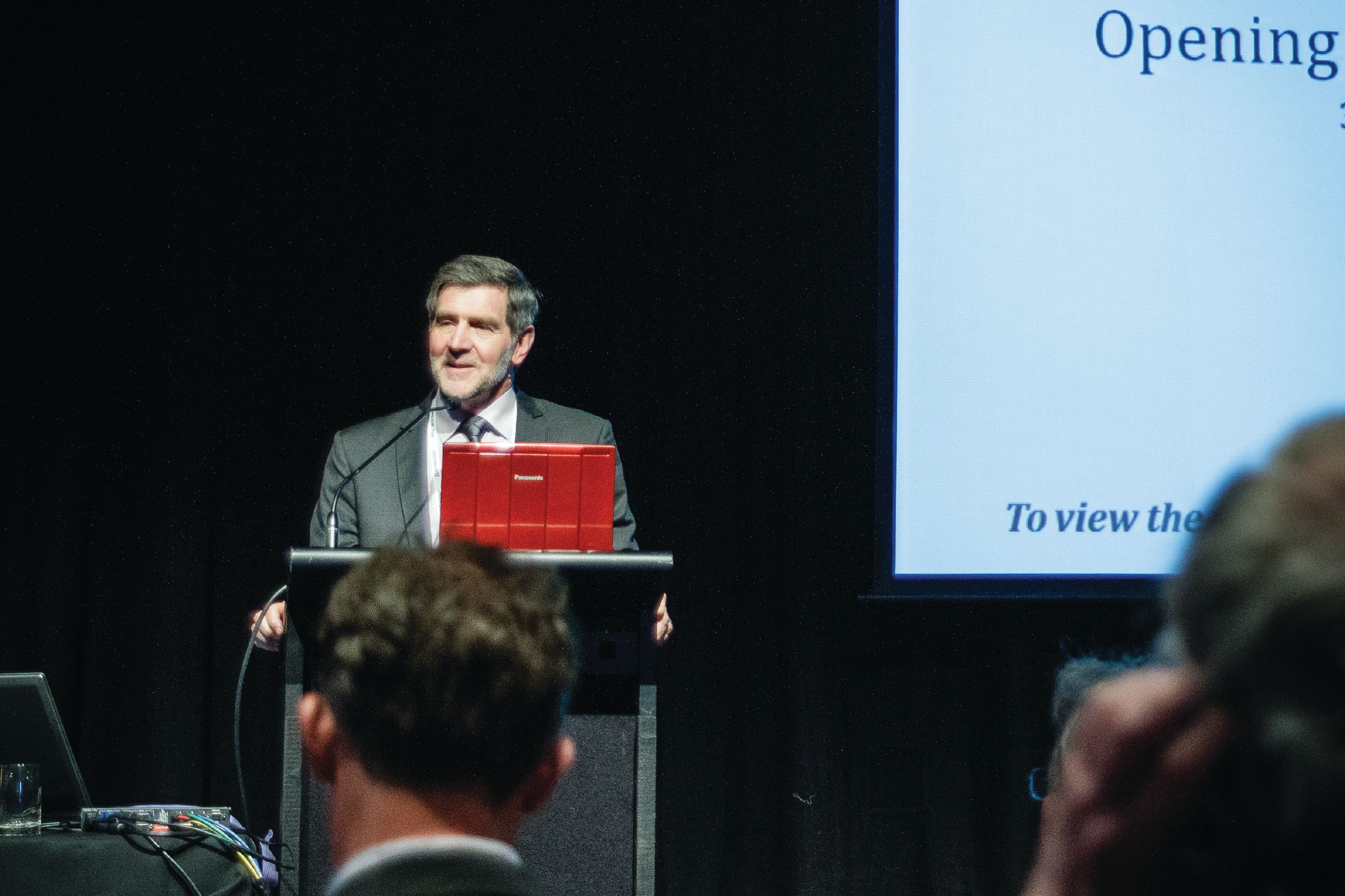
Haddad particularly likes this group photo which includes all of ACROSS at a function during the HPLC 2013 conference in Hobart, which Haddad and Hilder co-chaired. “It shows the scale of what he built in ACROSS,” said Hilder. Image and caption courtesy of Emily Hilder.
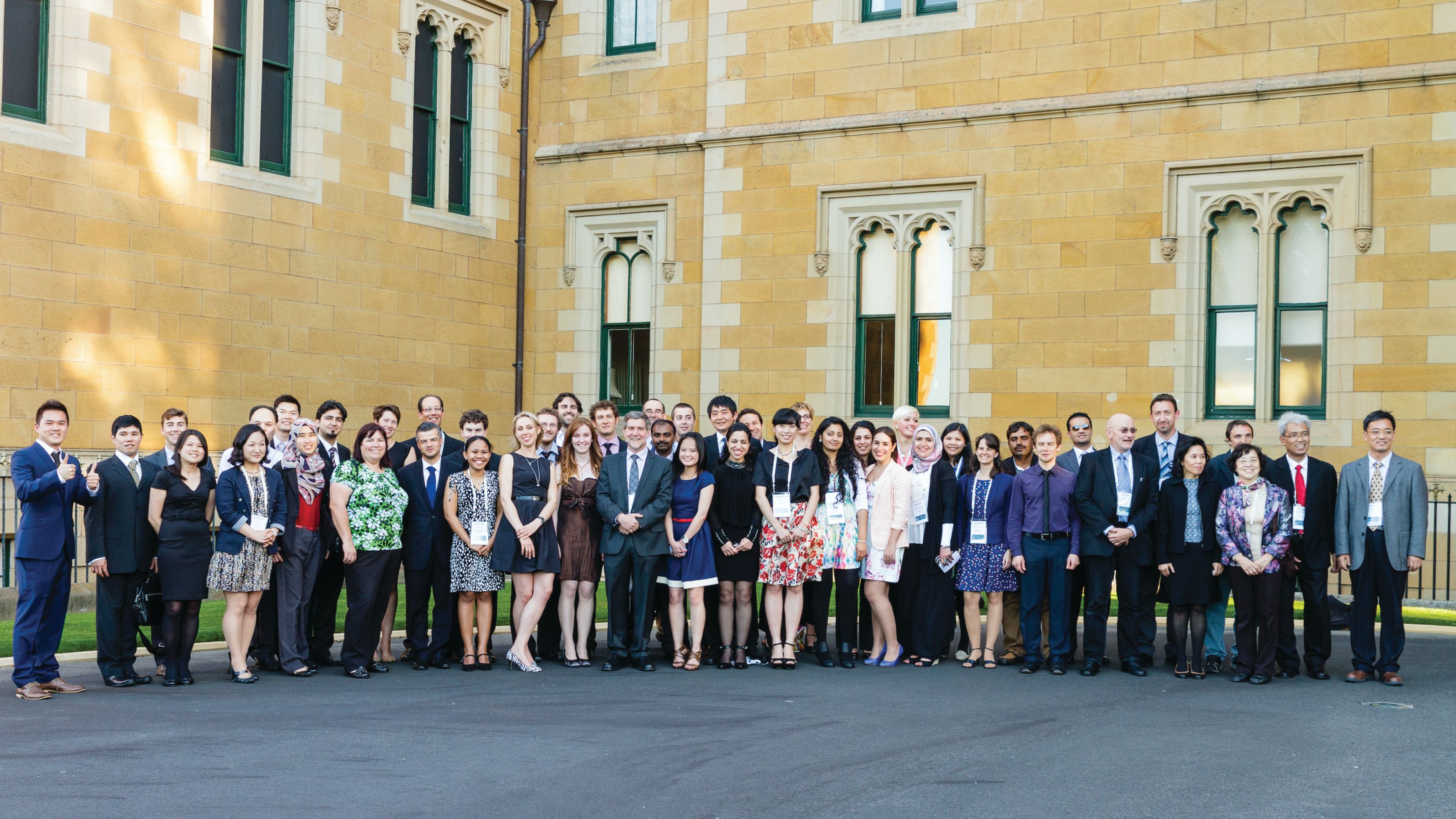
Key Career Publications: Most Cited
Haddad’s key publications include two reference textbooks. The first is Ion Chromatography: Principles and Applications (Elsevier, 1990) (6), The first book currently has 731 Google Scholar (G.S.) citations and is widely used as a comprehensive reference for ion chromatography (IC). With 22 chapters and more than 750 pages of detail, the book is a wealth of information, providing IC researchers and professional analytical scientists the type of information they would find most valuable and helpful. The book contains many equations, figures, and data tables and is prolifically referenced. The second book is Principles and Practice of Modern Chromatographic Methods (Academic Press, 1994) (7). With nine chapters and nearly 500 total pages, it covers the theory and practice of chromatographic methods and topics, such as GC, planar chromatography, HPLC instrumentation and techniques, HPLC separations, supercritical fluid chromatography (SFC), sample handling, and qualitative and quantitative analysis. This text has 283 G.S. citations.
Haddad’s paper with the third highest citations (272 G.S.) reviews the subject of leaching and recovery of gold using ammoniacal thiosulfate liquors (8). The review describes the current application of ion exchange resins for recovery of gold and silver from such leach liquors. Thiosulfate leaching chemistry is compared with cyanide leaching. Comparisons are also made with other leach liquor recovery processes, such as carbon adsorption, solvent extraction, electrowinning and precipitation.
Another review by Haddad received the fourth highest level of citations (187 G.S.) (9). The review describes the details of recent developments (circa 2008) in the field of ion chromatography (IC). The topics covered in the review are new stationary (monolithic) phases, miniaturized IC systems, enhanced peak capacity through computer tools for simulation and prediction of retention, hyphenated IC systems and their use for speciation and metallomics studies, and IC in bioanalysis.
The fifth highest cited work from Haddad (159 G.S.) is a review paper describing the integration of conductivity detection for conventional and miniaturized capillary electrophoresis (CE) systems (10). As the paper points out, the application of microfabrication technology enables precise alignment of electrodes, resulting in the widespread use of conductivity detection for microfluidic devices. For contactless conductivity detection (CCD) used in CE, the precise alignment of the electrodes with respect to the capillary element is not critical. In addition, a description of contactless conductivity detection (CCD) as applied for CE systems is included within this review paper.
(L to R) Mirek Macka and Paul Haddad celebrating a cover image for an Analytical Chemistry feature article in earlier days, from Anal. Chem. 70(4) 743–749 (1998). Image and citation courtesy of Michael Breadmore, originally from ACROSS.
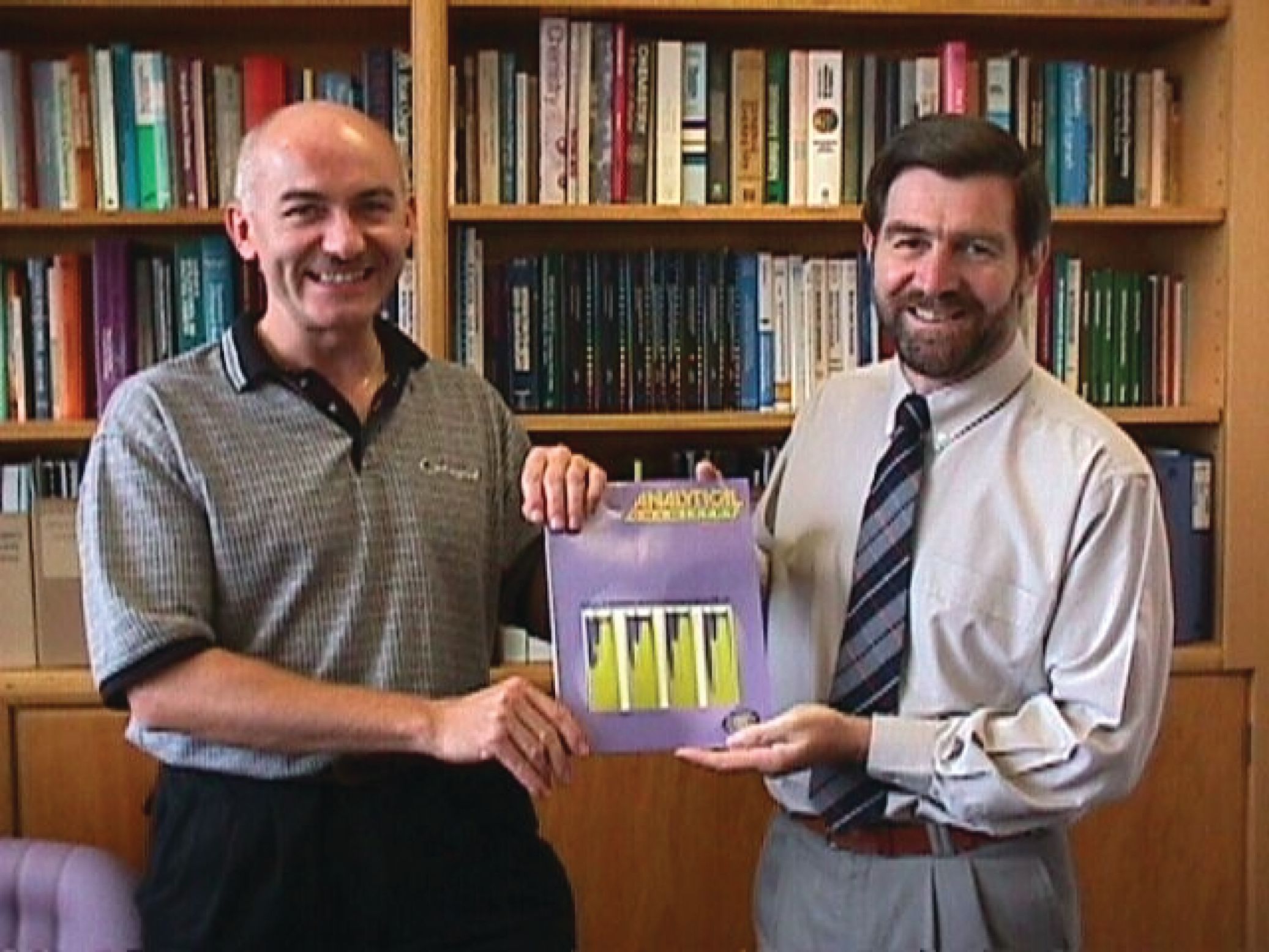
At the reception for the American Chemical Society (ACS) Chromatography Award. (L to R) Paul and his wife Kerry, with Gary Christian and Sandy Dasgupta. Image courtesy of Sandy Dasgupta.

Key Career Publications: Most Cited
Haddad’s key publications include two reference textbooks. The first is Ion Chromatography: Principles and Applications (Elsevier, 1990) (6), The first book currently has 731 Google Scholar (G.S.) citations and is widely used as a comprehensive reference for ion chromatography (IC). With 22 chapters and more than 750 pages of detail, the book is a wealth of information, providing IC researchers and professional analytical scientists the type of information they would find most valuable and helpful. The book contains many equations, figures, and data tables and is prolifically referenced. The second book is Principles and Practice of Modern Chromatographic Methods (Academic Press, 1994) (7). With nine chapters and nearly 500 total pages, it covers the theory and practice of chromatographic methods and topics, such as GC, planar chromatography, HPLC instrumentation and techniques, HPLC separations, supercritical fluid chromatography (SFC), sample handling, and qualitative and quantitative analysis. This text has 283 G.S. citations.
Haddad’s paper with the third highest citations (272 G.S.) reviews the subject of leaching and recovery of gold using ammoniacal thiosulfate liquors (8). The review describes the current application of ion exchange resins for recovery of gold and silver from such leach liquors. Thiosulfate leaching chemistry is compared with cyanide leaching. Comparisons are also made with other leach liquor recovery processes, such as carbon adsorption, solvent extraction, electrowinning and precipitation.
Another review by Haddad received the fourth highest level of citations (187 G.S.) (9). The review describes the details of recent developments (circa 2008) in the field of ion chromatography (IC). The topics covered in the review are new stationary (monolithic)phases, miniaturized IC systems, enhanced peak capacity through computer tools for simulation and prediction of retention, hyphenated IC systems and their use for speciation and metallomics studies, and IC in bioanalysis.
The fifth highest cited work from Haddad (159 G.S.) is a review paper describing the integration of conductivity detection for conventional and miniaturized capillary electrophoresis (CE) systems (10). As the paper points out, the application of microfabrication technology enables precise alignment of electrodes, resulting in the widespread use of conductivity detection for microfluidic devices. For contactless conductivity detection (CCD) used in CE, the precise alignment of the electrodes with respect to the capillary element is not critical. In addition, a description of contactless conductivity detection (CCD) as applied for CE systems is included within this review paper.
Collaborative Research
Numerous scientists have enjoyed collaborating with and being supported by Haddad over the years. One of those is Brett Paull, the Associate Dean of Research of the College of Science and Engineering at the University of Tasmania. When Paull joined the chemistry department in 1995 at the university as a junior lecturer, he immediately began working with the rapidly growing Separation Science Research Group (SSRG).
“Paul was head of the group and I spent the next two and a half years working with Paul on various projects,” Paull said. “Paul provided great mentorship and support during that time, and ever since them we have remained close friends and research collaborators.”
Today, Paull and Haddad collaborate within ACROSS, the living descendant of that early SSRG.
Professor Emily Hilder, who is with the Defense Science and Technology Group at the Department of Defense in Australia, remembers being inspired by Haddad when he was her professor of chemistry.
“It was Paul who first introduced me to chromatography and I credit him with inspiring my love of chromatography and shaping my future career direction,” she said.
Michael Breadmore, a Professor of Chemistry and the current director of ACROSS has known Haddad since 1995.
“Paul was my first research project supervisor and the one that accepted me into his research group to do a PhD— Paul is generous, a man of integrity, and trustworthy,” he says.
Purnendu “Sandy” K. Dasgupta, the Hamish Small Chair in Ion Analysis in the Department of Chemistry and Biochemistry at the University of Texas at Arlington, remembers when he first met Haddad at the inaugural International Ion Chromatography Symposium in 1989. Dasgupta was immediately impressed by Haddad’s early work, and still is to this day.
“As the saying goes, imitation is the highest form of flattery—some four decades later I am presently admiring the beauty of doing electrochemistry at copper electrodes,” he said. “So it is fair to say I have been paying my tributes to Paul through my actions throughout the years up till now.”
Wolfgang Buchberger is a Full University Professor in Analytical Chemistry at the Johannes-Kepler-University Linz in Austria and has known Haddad since the late 1980s when Buchberger joined him as a post-doc at the University of New South Wales in Sydney.
“In the early 1990s Paul moved to Hobart (Tasmania). During the process of establishing a research group in separation science he offered me a position to be part of his team—I considered this a privilege,” he said.
Buchberger joined Haddad’s team for 1993 and 1994 and has continued to stay connected and collaborate since that time.
Greatest Contributions
When we asked others in the field to assess Haddad’s most important contributions to separation science, a common theme was that he made an impact in many ways.
Paull focused on Haddad’s development of many aspects of ion chromatography, and other modes of chromatography and electro-separation methods, targeted to small inorganic and organic ions. “He has gained a considerable reputation in the area of chromatographic modelling and retention time prediction algorithms, including work which has led to commercial products,” Paull says. “He has been involved in numerous applied projects across a whole range of industries, from mining to pharmaceuticals, and has led as director of multiple industry supported large-scale research initiatives and centers.”
“Paul has made outstanding contributions to the field of ion chromatography and is one of the pioneers and gurus in this field,” Hilder said.
Breadmore sees Haddad’s major influence in separation science in three main areas. First is the field of small-molecule analysis by ion chromatography, capillary electrophoresis, and more recently, by HILIC.
“He was, and still is, one of the most published authors in ion analysis,” he said.
Second is the field of computer aided optimization and method development.
“The development of software to help optimize conditions has been a significant aid to many users of ion chromatography,” he said. “Haddad’s recent work with other forms of chromatography for pharmaceuticals will hopefully have similar impact.”
Breadmore said that Haddad’s third main contribution is in training outstanding researchers that have gone on to make significant contributions to academia and industry.
Buchberger also named multiple areas, including Haddad’s work in modeling of chromatographic separations, prediction of retention times, systematic optimization of chromatographic resolution, and the foundation of ACROSS.
Dasgupta says that choosing Haddad’s most important contribution is difficult, because he has contributed to so many areas.
“I think Paul’s most lasting contribution is ACROSS, and specifically all the students and colleagues who flourished under his leadership,” he said. “It is hard to think about analytical chemistry in Australia if we take out all those researchers that ACROSS has touched in some way.”
Teacher and Mentor
Many expressed that Haddad is not just an outstanding scientist, but an outstanding teacher and mentor.
“I have learnt much more than chemistry and chromatography from Paul—about how to lead and manage people effectively, working effectively across academia and industry, and many other things without which I would not have been able to achieve so much in my own career to date,” says Hilder. “Paul’s legacy is not just his contributions to chromatography, which alone are very significant, but what he has done to build and support the careers of others, especially through his establishment and leadership of ACROSS.”
Brett Paull agrees. “He is well known for his unending support and loyalty to his past students and post-docs, right throughout their careers, rarely having a negative word to say,” Paull said. “In fact, that is a trait of Paul’s which is truly admirable, in that he has always been a leader who lets people make their own mistakes, without rushing to criticize, only provide support and advice.”
Paull adds that Haddad is an extremely loyal and reliable friend.
“He offers up his expert help for almost anything needed, from editing a first draft manuscript, all the way to house painting.”
Closing Remarks
Although Haddad has officially retired from the university, he has not stopped working—as evidenced from his 2020 publications. “He still co-supervises multiple PhD students, several with me, and is also still a named investigator on active research grants,” Paull said.
Dasgupta said, “Paul has not stopped, may this award be additional impetus for him to keep keeping on.”
“His contributions to date have been phenomenal and I think he deserves a rest if he wants one,” says Breadmore, “If he doesn’t, I think he will continue to explore the idea of predicting chromatographic behavior a priori using computer aided method development.”
References
(1) S.C. Lam, L.J. Coates, V. Gupta, H.J. Wirth, A.A. Gooley, P.R. Haddad, and B. Paull, J. Chromatogr. A 1631, 461540 (2020). doi.org/10.1016/j.chroma.2020.461540.
(2) M. Hemida, L.J. Coates, S. Lam, V. Gupta, M. Macka, H.-J. Wirth, A.A. Gooley, P.R. Haddad, and B. Paull, Anal. Chem. 92(20), 13688–13693 (2020). doi.org/10.1021/acs.analchem.0c03460.
(3) L.J. Coates, S.C. Lam, A.A. Gooley, P.R. Haddad, B. Paull, and H.J. Wirth, J. Chromatogr. A 1626, 461374 (2020). doi.org/10.1016/j.chroma.2020.461374.
(4) F. Harati, A. Ghiasvand, K. Dalvand, and P.R. Haddad, Microchem. J. 155, 104672 (2020). doi.org/10.1016/j.microc.2020.104672.
(5) P.R. Haddad, M. Taraji, and R. Szücs, Anal. Chem. (2020). doi.org/10.1021/acs. analchem.0c04190.
(6) P.R. Haddad and P.E. Jackson, Ion Chromatography: Principles and Applications (Elsevier, Amsterdam, 1990).
(7) K. Robards, P.R. Haddad, and P.E. Jackson, Principles and Practice of Modern Chromatographic Methods (Academic Press, Boston, Massachusetts, 1994).
(8) A.C. Grosse, G.W. Dicinoski, M.J. Shaw, and P.R. Haddad, Hydrometallurgy 69(1–3), 1–21 (2003).
(9) P.R. Haddad, P.N. Nesterenko, and W. Buchberger, J. Chromatogr. A 1184(1–2), 456–473 (2008). doi.org/10.1016/j.chroma.2007.10.022.
(10) R.M. Guijt, C.J. Evenhuis, M. Macka, and P.R. Haddad, Electrophoresis 25(23–24), 4032–4057 (2004). doi.org/10.1002/elps.200406156.
The Emerging Leader Award
The Emerging Leader in Chromatography Award recognizes the achievements and aspirations of a talented young separation scientist who has made strides early in his or her career toward the advancement of chromatographic techniques and applications.
Erik L. Regalado, the 2021 winner, is a Principal Scientist in the analytical research and development (AR&D) department at Merck Research Laboratories, where he leads the Method Screening and Purifications group. His work focuses on analytical and preparative enabling technologies that accelerate the development of new pharmaceuticals, including automated method screening, multidimensional chromatography, high-throughput analysis, and ultrafast and computer-assisted separations.
Regalado received a PhD in chemistry from the University of Havana, in Cuba, in collaboration with the University of Nice Sophia Antipolis in France in 2011. He received a MS in organic chemistry in 2007, and a BS in chemistry in 2003, both from the University of Havana in Cuba.
Key Research Publications
In his efforts to improve the performance of analytical and purification separations of pharmaceutical compounds, Regalado has employed a range of separation techniques and modeling approaches. Here are his latest publications as examples.
In his most recent paper, an extract of a Dactylia sp. nov. marine sponge, Regalado and colleagues have identified seven new arylpyrrole alkaloids and four known compounds by interpretation of both nuclear magnetic resonance (NMR) and mass spectrometry (MS) data (11). The molecular structures of denigrins D–G, dactylpyrroles A–C, denigrin D, and dictyodendrin F were described in detail using these analytical techniques.
In another recent study, Regalado and colleagues introduced multifactorial peak crossover (MPC) via computer-assisted chromatographic modeling to address challenging coelutions of critical pairs and poor chromatographic productivity of purification methods (12). This MPC approach allows mapping of separation parameters in pharmaceutical mixtures to enable switching the elution order of target analytes. The MPC technique is reported to dramatically reduce development time for analytical and preparative-scale separations. In addition, MPC chromatography is reported to improve signal-to-noise ratio (S/N) for parts per billion (ppb) detection of metabolites and genotoxic impurities.
Regalado has reported the development and implementation of a customized online multicolumn two-dimensional liquid chromatography–diode array detection–mass spectrometry (2D-LC-DAD-MS) workflow system (13).
The system is designed for method development and screening specifically to analyze multicomponent biopharmaceutical mixtures. Excellent chromatographic performance was demonstrated for peak shape, selectivity, and peak reproducibility for reversed-phase liquid chromatography (RPLC), strong cation exchange (SCX), strong anion exchange (SAX), and size exclusion chromatography (SEC). A sub-2-μm column was used for the first dimension combined with multiple column in the second dimension. This technique may be used for semi-automated development of 2D-LC methods, especially for protein-based drug analysis.
Another important publication of Regalado’s introduces a new concept for multidimensional chromatography: the first report of automated multicolumn 2D-LC screening for facile selection of stationary- and mobile-phase conditions in both dimensions (14).
In another recent paper, Regalado and associate researchers demonstrated a matrix-assisted laser desorption/ionization time-of-flight (MALDI-TOF)-MS method for determining peptide and protein permeability through an artificial liposome membrane using a hydrogen-deuterium exchange (HDX) technique (15). The technique is referred to as the liposome artificial membrane permeability assay (LAMPA) workflow and was used to study three previously characterized membrane-active model peptides—melittin, alamethicin, and gramicidin. In this work a non-aqueous (aprotic) matrix solution was designed to quench unwanted HDX, and peak area ratio was calculated for labeled vs. unlabeled peptides using MALDI to indicate permeability. The method requires labeling peptides on the outside of the liposomes via exposure to deuterium oxide, while the peptides inside the liposomes are not labeled. The proposed LAMPA-MALDI-HDX-MS technique can be used for ultra-high-throughput analysis to rank-order peptides and small proteins for their membrane permeability properties.
Regalado and Makarov at the HPLC 2019 conference in Milan. Image courtesy of Alexey A. Makarov.
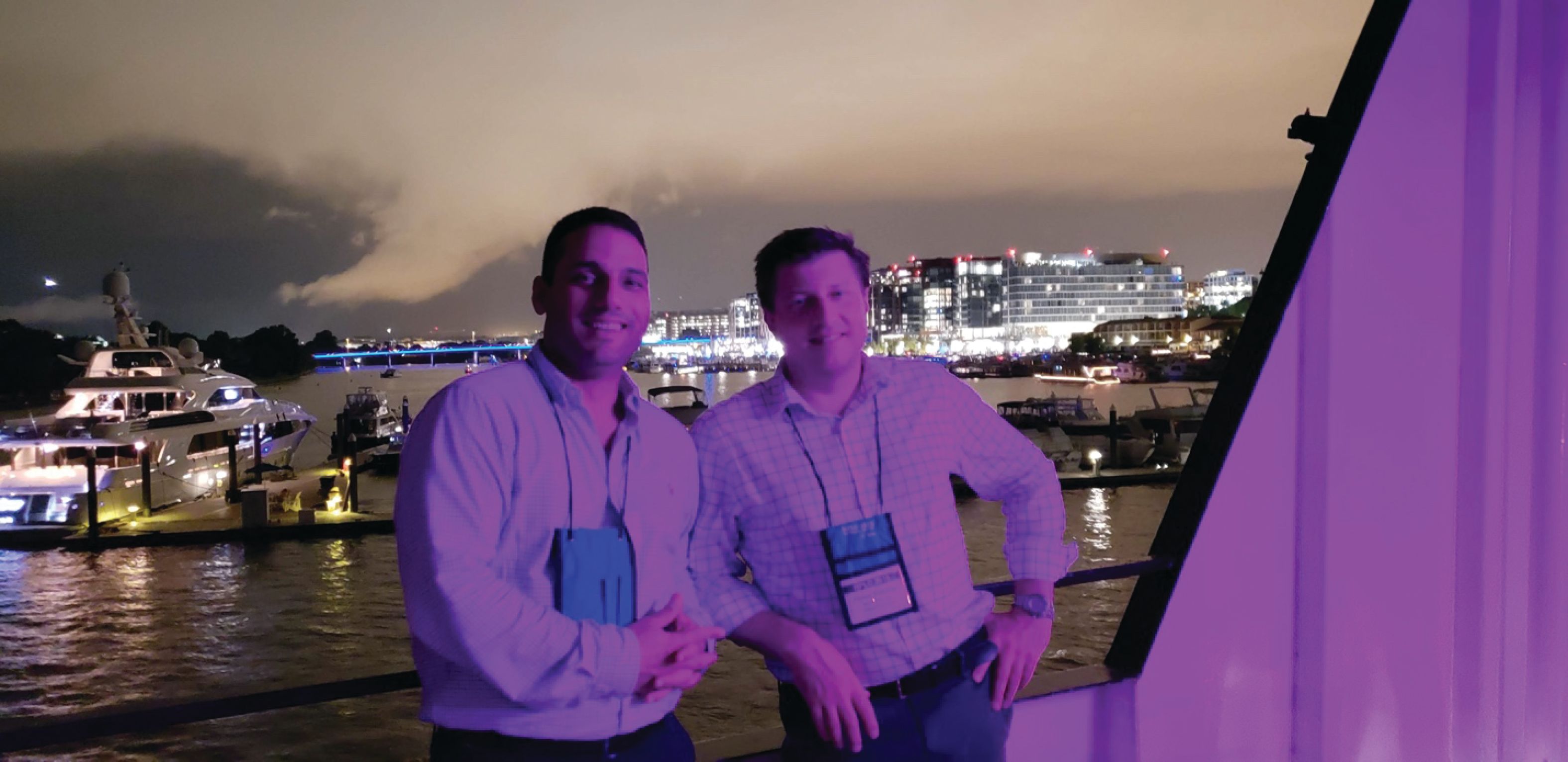
A recent review paper published by Regalado includes academic and industry reports on the emergence of universal chromatographic methods in the research and development of new drug substances (16). Regalado also has become one of the leaders of this field that is transforming analysis in pharmaceutical R&D laboratories.
Other work focuses on improving supercritical fluid chromatography for preparative-scale purifications. By introducing a simple and highly efficient enhanced SFC (eSFC) approach, Regalado and coworkers reported analysis and purification of over 40 α,α-diaryl primary amine mixtures, overcoming limitations of traditional chromatographic methods (17). The eSFC approach is reported to deliver significant method improvements for simplicity and greenness, such as improved chromatographic performance; augmented eSFC–MS and preparative MS purifications; and direct solvent removal with minimal solvent use. He also recently published work that demonstrates a revolutionary concept that introduces chaotropic effects in SFC (18). This new strategy has enabled Regalado’s group at Merck to deliver highly pure cyclic peptides at kilogram scale, something unprecedented in purification laboratories. In addition, the concept helped extending the reach of SFC to molecules that were previously considered out of the scope of the technique.
Regalado presenting at the at the HPLC 2018 conference in Washington, DC. Image courtesy of Alexey A. Makarov.
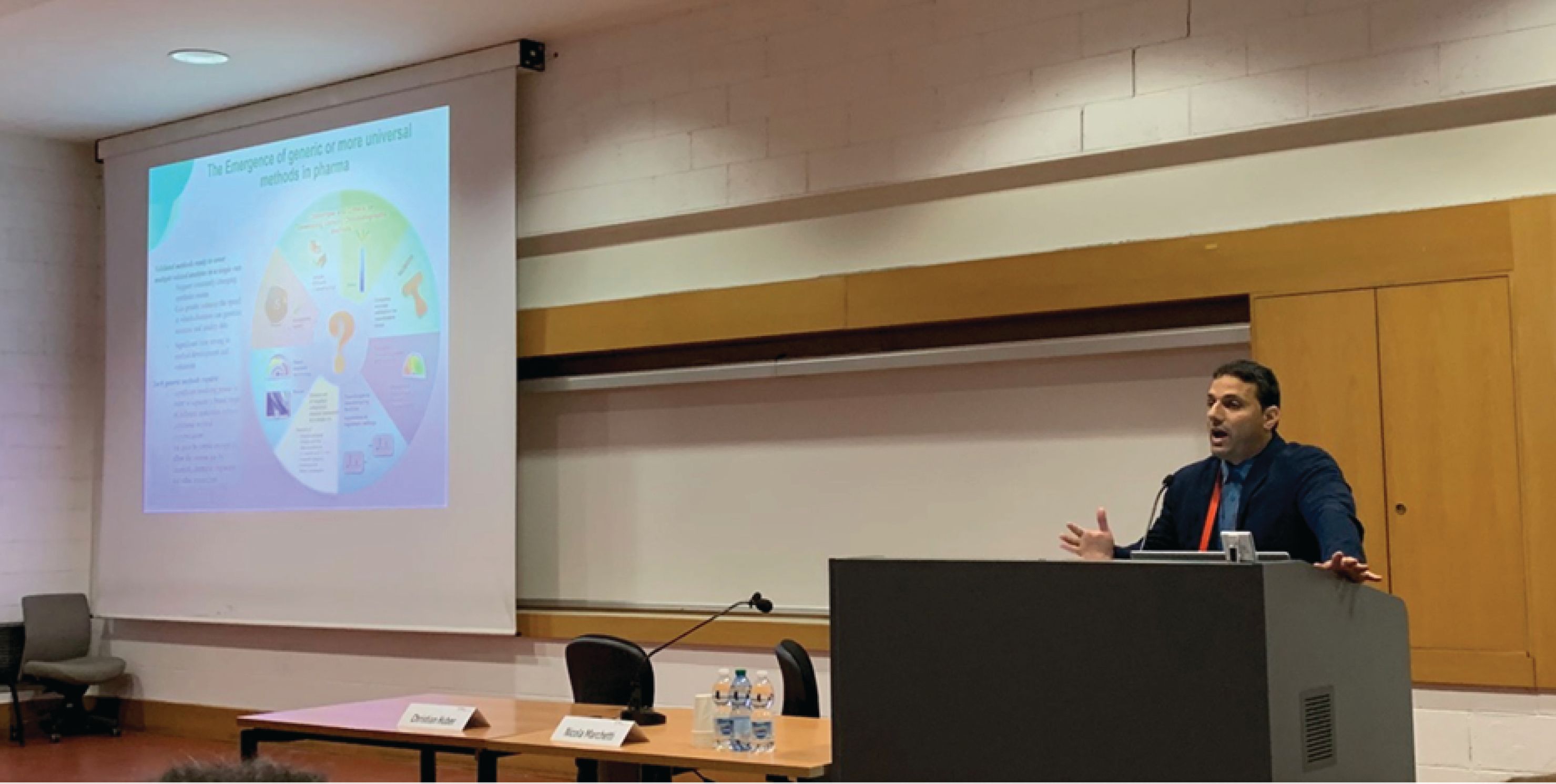
Key Career Publications: Most Cited
Regalado’s most cited paper (264 citations in Google Scholar (G.S.)), demonstrates an automated dosing and characterization protocol for optimizing chemical reaction conditions for synthesizing compounds on a microgram scale (19). This research used palladium-catalyzed cross-coupling reactions to develop automation-friendly reactions to be completed in dimethyl sulfoxide (DMS) at room temperature. This advance enabled the coupling of robotics and mass spectrometry–based high-throughput analysis techniques. The authors report that more than 1500 chemistry experiments were conducted in less than 24 h, with reaction material weights of 0.02 milligrams per reaction. Regalado’s second most cited paper (90 citations in G.S.), demonstrates a method for direct photocatalytic C–H fluorination used in the preparative synthesis of odanacatib (20). This reaction advanced the synthetic pathway for odanacatib—an investigational drug treatment for osteoporosis and bone metastasis.
In a paper receiving 86 citations, Regalado and coworkers described a methodology for ultrafast chiral separations useful for high throughput analysis of drug enantiopurity (21). The authors reported that enantio separations, using fast chromatographic techniques, allow high throughput analysis of enantiopurity within a few seconds for pharmaceutical drugs and intermediates. This research demonstrated that ultra-fast resolutions (≤1 min) are possible using both SFC and RPLC.
Regalado published a paper receiving 73 citations that proposed and demonstrated ultrafast two-dimensional liquid chromatography (2D-LC) for chiral separations in pharmaceutical products (22). The incorporation of a 2D-LC technique improves peak capacity and selectivity for chromatographic separations. Special combinations of achiral and chiral narrow-bore columns in the first dimension with highly efficient chiral selectors in the second dimension were successfully applied to the separation and analysis of complex mixtures for pharmaceuticals and synthetic drug intermediates.
In work during his graduate studies, five new hydantoin alkaloids, named parazoanthines A−E, were isolated by Regalado and colleagues as the major constituents of the Mediterranean sea anemone Parazoanthus axinellae using NMR spectroscopic and mass spectrometric analyses (23). The absolute configuration of two of the chiral compounds 1 and 4 was determined by comparison between experimental and time-dependent density functional (TDDFT) calculated circular dichroism (CD) spectra. This paper has received 71 citations to date.
An Innovator and Emerging Leader
Numerous collaborators and mentors have praised Regalado’s work and innovation.
Abilio Laguna Granja is currently a production researcher at Synergy Semiochemicals Ltd., in Surrey, British Columbia, Canada. He was Regalado’s mentor for his Master’s and PhD theses, together with Professor Clara Nogueiras from Havana University, and worked with Regalado from 2004 to 2012 in the Department of Chemistry at the Center for Marine Biology (CEBIMar).
“Since I have known Erik I have considered him the best young scientist I ever met,” he said.
“Erik has the ability to synthesize empirical facts into a clear picture,” said Alexey A. Makarov, a principal scientist in the AR&D group at Merck’s Boston location. “I believe one of his most significant accomplishments in the field of chromatography is revealing chaotropic effects on peptides during SFC separation.”
This approach has since been extensively applied to the separation and purification of reaction mixtures of many polar pharmaceuticals, such as organo-halogenated species, nucleobases, nucleosides, nucleotides, sulfonamides, and cyclic peptides, and resulted in a publication in Analytical Chemistry.
Robert Hartman is currently the Director of Integrated Development and Supply Team, Center of Excellence (IDST CoE) for Quality at Merck Research Laboratories in Rahway, New Jersey. Regalado worked with Hartman for several years when Hartman led the AR&D group.
“Erik is one of the most enthusiastic and hardworking analytical chemists that I’ve had the pleasure of knowing,” Hartman said, adding that Regalado would often call or text him late at night or during the weekend to share a new idea he had or a recent breakthrough in an analytical challenge. “Erik truly loves being an analytical chemist, solving challenging problems and sharing these learnings through presentations, conferences, publications and late-night calls to his friends.”
Christopher Welch is the Executive Director of the Indiana Consortium for Analytical Science & Engineering (ICASE) in Fishers, Indiana, and the former Distinguished Scientist for Process & Analytical Chemistry at Merck, where he hired and supervised Regalado’s post-doctoral research.
“When I met Erik in the interview stage, it was clear that we would work well together and that he wanted the same thing that I wanted . . . an opportunity to work hard, carry out interesting research, and publish some great science,” Welch said.
Daniel W. Armstrong, the R.A. Welch Distinguished Professor at the University of Texas at Arlington, first got to know Regalado in 2010 after the two met at various conferences, They dis- covered their mutual interests in chiral separations, fast separations, and super critical fluid chromatography—among others, and ended up having several joint publications.
“Erik has made contributions in many different areas, but his work in high throughput analyses, particularly of pharmaceutically important compounds, certainly stands out,” Armstrong said.
Davy Guillarme is a senior lecturer and research associate at the University of Geneva in Switzerland and has known Regalado since 2013, when Erik was doing his post-doctoral work at Merck. The two began collaborating in 2018.
“Regalado has developed a significant number of platform methods for a wide range of molecules having very diverse physicochemical properties,” Guillarme says. “In particular, he has developed some analytical strategies making it possible to obtain very fast chiral separations and solutions to obtain both chemical and enantio selectivity within the same run, by combining achiral and chiral LC in a 2D-LC setup.”
Ian Mangion is the Executive Director of Analytical Enabling Technologies at Merck in Cranford, New Jersey. “I rely on Erik to drive innovation and advances in automation and modeling in method development and separations of a wide diversity of chemical matter across modalities.” Mangion said. “Erik is reliably one of the most productive innovators in the field of separation sciences, but perhaps his greatest contribution is the way he has collaborated with leading research labs and his pharmaceutical colleagues to facilitate substantive advances in the speed and productivity of our work.”
In 2015 Regalado won the award for the most publications of any Merck postdoctoral researcher. The plaque presented to him at the annual postdoc symposium was inscribed “Publication Monster,” featuring an image of Godzilla holding many manuscripts. During his first year as a postdoctoral fellow, Erik contributed to the publication of 18 impactful articles, which included contributing to a publication in the journal Science. Comments and image courtesy of Alexey A. Makarov and Robert Hartman, respectively.
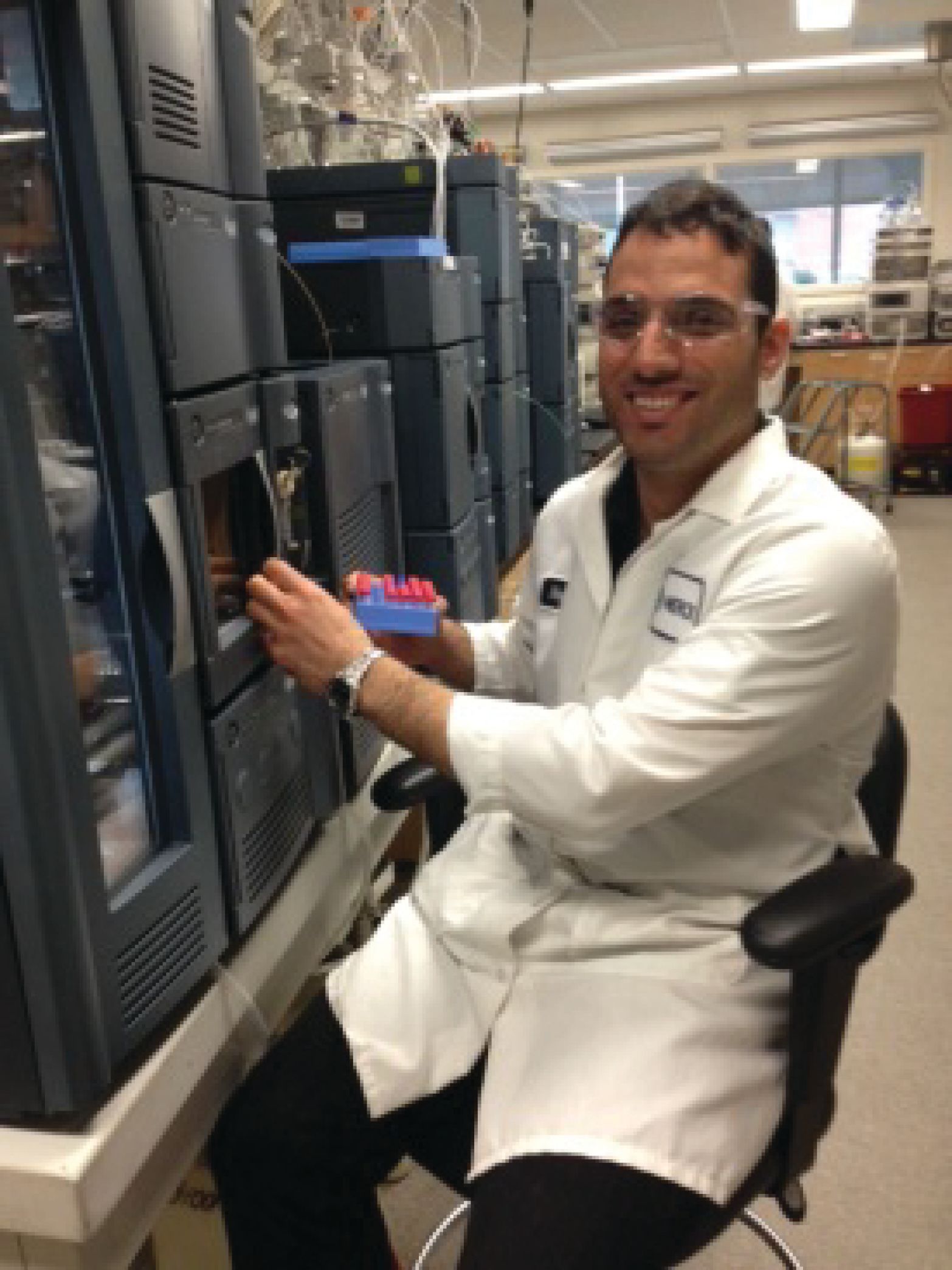
From the 2020 LCGC Lifetime Achievement Award session at PittCon. Regalado is the second from the left along with an incredible array of fellow distinguished scientists. From left to right: Jim Luong, Regalado, Milton Lee, Kevin Schug, Fabrice Gritti, Daniel W. Armstrong, Zach Breitbach, Farooq Wahab, Laura Bush, Len Sidisky and Abiur Portillo. Image submitted by Daniel Armstrong.

The Future
Given Regalado’s impressive work so far—exemplified by his 18 impactful publications during the first year of his postdoctoral fellowship, including contributing to a publication in the journal Science—the community expects his impact to continue.
“I know that he will continue working hard while obtaining many great results that will be published in top levels journals,” said Laguna Granja. “I hope that Dr. Regalado will continue to increase his knowledge in the field of LC and GC chromatography and will become one of the top leaders in the field.”
Makarov says that Regalado is growing to become a great scientific and group leader at Merck.
“He is now leading the Purification and High–Throughput Screening Lab,” Makarov said. “This brings him to a new level of influence and innovation leadership.”
Hartman said that he sees Regalado continuing to advance his career as a leader in Merck’s analytical mission to solve modality agnostic challenges using cutting-edge analytical technologies.
“Erik is one of the most enthusiastic and hardworking analytical chemists that I’ve had the pleasure of knowing,” Hartman said. “He is doing well at Merck and leading a strong group. I expect great things from him.”
“Based on his qualities, I am sure Erik will become one of the most impactful people in pharmaceutical analysis in the future,” commented Guillarme “Indeed Erik’s inventiveness and practical problem-solving in chromatography is largely renowned, bringing great value to both pharmaceutical industry and academia.”
“What he has done as an industrial chemist is almost unbelievable; he has more and better research publications than most academic chemists in the field,” says Armstrong. “I can only see him continuing to go onwards and upwards in his research reputation and contributions.”
References
(11) U. Kang, L.K. Cartner, D. Wang, C.-K. Kim, C.L. Thomas, G.M. Woldemichael, B.E. Gryder, J.F. Shern, J.Khan, C. Castello-Branco, E.C. Sherer, X. Wang, E.L. Regalado, and K.R. Gustafson, J. Nat. Prod. 83(11), 3464–3470 (2020). doi.org/10.1021/acs.jnatprod.0c01103.
(12) I.A. Haidar Ahmad, V. Shchurik, T. Nowak, B.F. Mann, and E.L. Regalado, Anal. Chem. 92(19), 13443–13451 (2020). doi. org/10.1021/acs.analchem.0c02807.
(13) C.J. Pickens, I.A.H. Ahmad, A.A. Makarov, R. Bennett, B.F. Mann, and E.L. Regalado, Anal. Bioanal. Chem. 412, 2655–2663 (2020).doi.org/10.1007/s00216-020-02498-8.
(14) H. Wang, H.R. Lhotka, M. Potapenko, C.J. Pickens, B.F. Mann, I.A. H. Ahmad, and E.L. Regalado, J. Chromatogr. A (2020). doi.org/10.1016/j.chroma.2020.460895.
(15) A.A. Makarov, G.F. Pirrone, V. Shchurik, E.L. Regalado, and I. Mangion, Anal. Chim. Acta 1099, 111–118 (2020). doi. org/10.1016/j.aca.2019.09.063.
(16) E.L. Regalado, I.A. Hadar Ahmad, R. Bennett, V. D’Atri, A.A. Makarov, G.R. Humphrey, I. Mangion, and D. Guillarme, Acc. Chem. Res. 52(7), 1990–2002 (2019). doi.org/10.1021/acs.accounts.9b00068.
(17) J.O. DaSilva, D. Lehnherr, J. Liu, R.Bennett, I.A. Haidar Ahmad, M. Hicks, B.F. Mann, D.A. DiRocco, and E.L. Regalado, ACS Sustain. Chem. Eng. 8(15), 6011–6021 (2020). doi.org/10.1021/acssuschemeng.0c00777.
(18) J. Liu, A.A. Makarov, R. Bennett, I.A. Haidar Ahmad, J. DaSilva, I. Mangion, B.F. Mann, and E.L. Regalado, Anal Chem. 91(21), 13907–13915 (2019). doi.org/10.1021/acs.analchem.9b03408.
(19) A.B. Santanilla, E.L. Regalado, T. Pereira, M. Shevlin, K. Bateman, L.-C. Campeau, J. Schneeweis, S. Berritt, Z.-C. Shi, P. Nantermet, Y. Liu, R. Helmy, C.J. Welch, P. Vachal, I.W. Davies, T. Cernak, and S.D. Dreher, Science 347(6217), 49–53 (2015). doi.org/10.1126/science.1259203
(20) S.D. Halperin, D. Kwon, M. Holmes, E.L. Regalado, L.C. Campeau, D.A. DiRocco, and R. Britton, Org. Lett. 17(21), 5200–5203 (2015). doi.org/10.1021/acs.orglett.5b02532
(21) C.L. Barhate, L.A. Joyce, A.A. Makarov, K. Zawatzky, F. Bernardoni, W.A. Schafer, D.W. Armstrong, C.J. Welch, and E.L. Regalado, Chem. Commun. 53(3), 509–512 (2017). doi.org/10.1039/C6CC08512A.
(22) C.L. Barhate, E.L. Regalado, N.D. Contrella, J. Lee, J. Jo, A.A. Makarov, D.W. Armstrong, and C.J. Welch, Anal. Chem. 89(6), 3545–3553 (2017). https://doi.org/10.1021/acs.analchem.6b04834.
(23) N. Cachet, G. Genta-Jouve, E.L. Regalado, R. Mokrini, P. Amade, G. Culioli, and O.P. Thomas, J. Nat. Prod. 72(9), 1612–1615 (2009). doi.org/10.1021/np900437y.
Jerome Workman, Jr. is Senior Technical Editor for LCGC North America and Spectroscopy. Direct correspondence about this article to: jworkman@mmhgroup.com
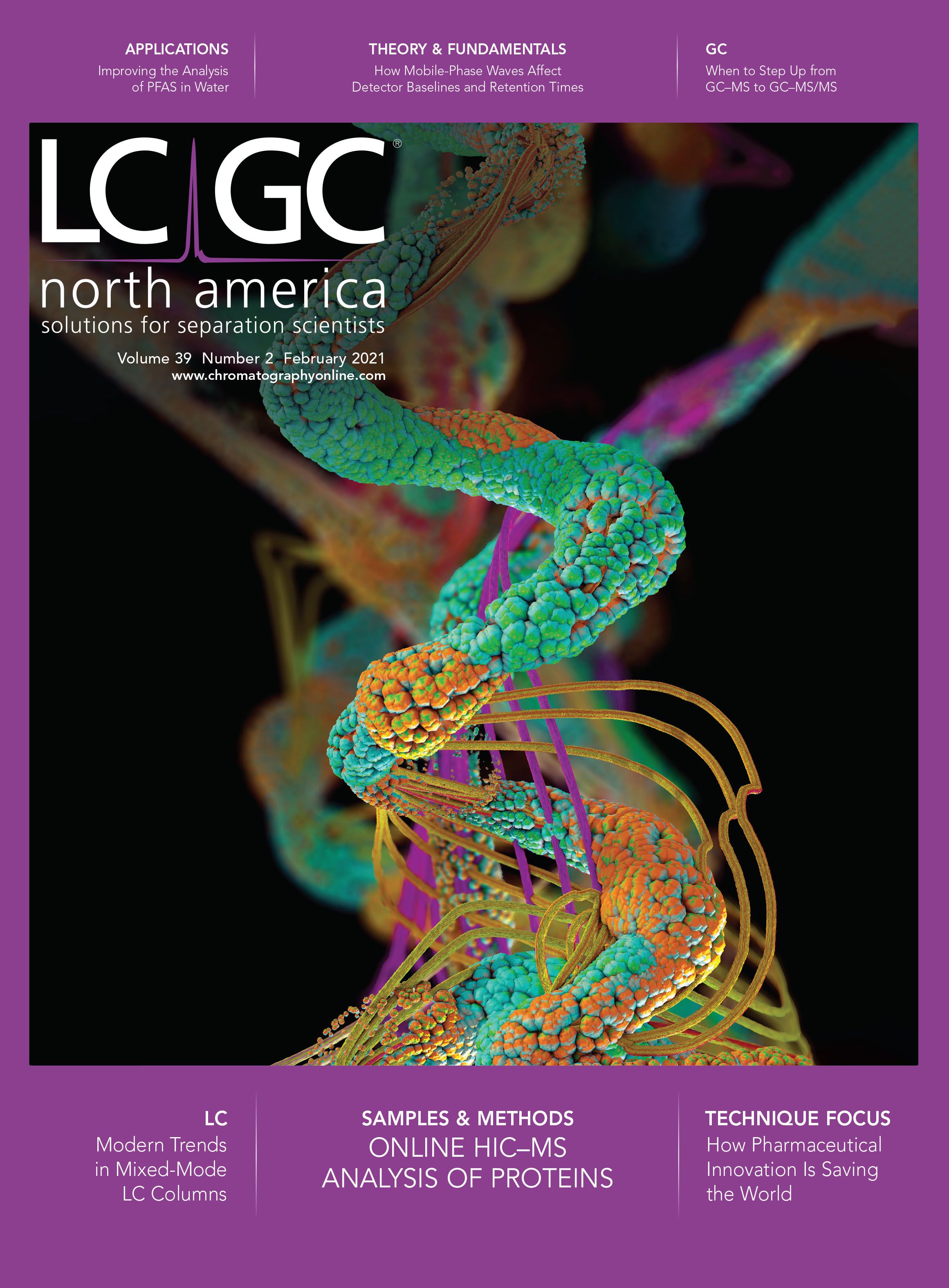
Study Explores Thin-Film Extraction of Biogenic Amines via HPLC-MS/MS
March 27th 2025Scientists from Tabriz University and the University of Tabriz explored cellulose acetate-UiO-66-COOH as an affordable coating sorbent for thin film extraction of biogenic amines from cheese and alcohol-free beverages using HPLC-MS/MS.
New Study Investigates Optimizing Extra-Column Band Broadening in Micro-flow Capillary LC
March 12th 2025Shimadzu Corporation and Vrije Universiteit Brussel researchers recently investigated how extra-column band broadening (ECBB) can be optimized in micro-flow capillary liquid chromatography.









